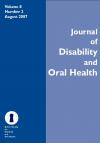Journal of Disability and Oral Health

- Cover Date:
- August 2007
- Print ISSN:
- 1470-8558
- Electronic ISSN:
- 1754-2758
- Vol:
- 8
- Issue:
- 2
Descriptive study of factors modifying the periodontal status of a population of people with a learning disability in Spain
Objectives: To evaluate, for institutionalised people with a learning disability: their periodontal status, periodontal treatment needs, the influence of social and demographical factors, behaviour, dental maintenance and malocclusions on their periodontal state. Subjects: 143 adults (17.5±3.5 years) with a learning disability in residential care. Design: Data were recorded relating to age, gender, illness, difficulties in behavioural management, residential status (resident/non-resident), previous contacts with dentists, and oral hygiene. The Community Periodontal Index of Treatment Needs (CPITN), periodontal treatment needs (TN) and malocclusion (WHO: 0, 1 and 2), were registered in accordance with the criteria of the World Health Organisation (WHO). Results: 24.3% had a congenital learning disability and 20.8% were diagnosed with Down syndrome. 79.0% of subjects were non-resident; 77.6% had a dental management issue; for 61.1% it was their first dentist contact; 41.9% brushed their own teeth. For malocclusion; 10.5% had none, 15.4% had mild and 74.1% moderate/advanced. For periodontal health; 4.2% had good health, 4.1% had bleeding, 59% calculus, 25.7% moderate pockets and 7% deep pockets. None of the patients was totally edentulous. Periodontal disease increased with age (p<0.001) and women had better periodontal health (p<0.01). Patients who had their teeth brushed by their carers had better periodontal health (p<0.05). 4.2% require no treatment, 95.1% required instruction in oral hygiene, 91% instruction and calculus removal; 6.3% advanced periodontal treatment. Treatment needs increased with age (p<0.001), with difficulty in management (p<0.001), and whether they brushed their own teeth (p<0.05). Conclusions: A high level of mild/moderate periodontal disease was observed in the sample. This increased with age, with the presence of malocclusions and with unsupervised brushing. Key words: CPITN, disabled patients, handicap, periodontal treatment needs, periodontal status
- Article Price
- £15.00
- Institution Article Price
- £15.00
- Page Start
- 73
- Page End
- 80
- Authors
- Guillermo Machuca, Antonio F Sánchez, Carmen Machuca, Pedro Bullón
Articles from this issue
- Title
- Pg. Start
- Pg. End
- Referral patterns and access to dental services of people affected by homelessness in Dublin, Ireland
- 51
- 56
- An audit of patient assessment and treatment outcomes in anxious patients referred for conscious sedation
- 57
- 62
- Descriptive study of factors modifying the periodontal status of a population of people with a learning disability in Spain
- 73
- 80
